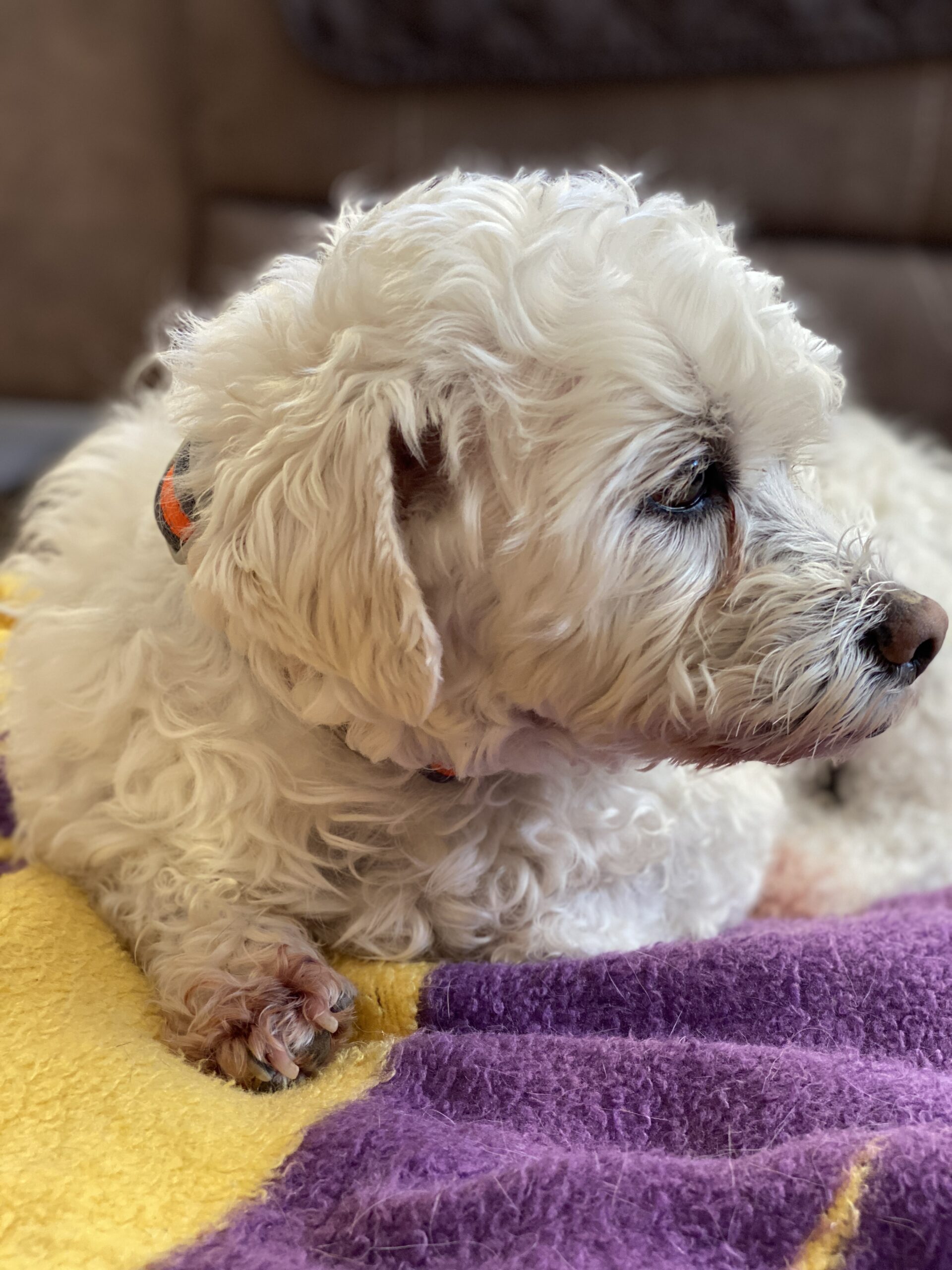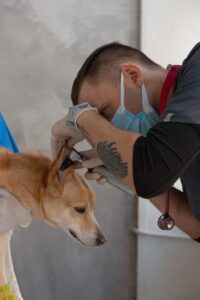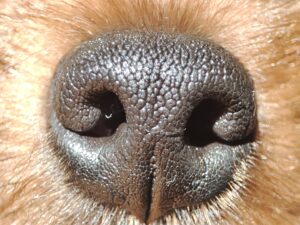Recent Posts
- Understanding Dog Food Labels: The Ultimate Guide to Raw Feeding vs. Kibble
- Debunking Dog Training Myths: The Truth About Breeds, Age, and Tools
- The Benefits of Adopting a Rescue Dog: Giving a Second Chance at Life
- The Ultimate Guide to Managing Dog Allergies
- The Science of Canine Sleep: Understanding Your Dog’s Sleep Patterns and Needs
Categories

The Ultimate Guide to Managing Dog Allergies
Dog Allergies and How to Resolve Them
Dogs, like humans, can suffer from various allergies that can impact their health and wellbeing. In this article, we will discuss the causes, symptoms, and treatment of dog allergies, and explore how innovative solutions like climate-controlled slat mills and K9 Sprinter can help eliminate these issues.
How Dogs Get Allergies
Allergies in dogs happen when their body’s defense system, called the immune system, thinks something harmless is actually dangerous. These harmless things are called allergens. Just like people, dogs can be allergic to different things. Here are some common allergens that can cause allergies in dogs:
- Pollen
- Mold spores
- Dust mites
- Flea bites
- Certain foods

Pollen
When dogs breathe in pollen or touch it, their immune system might think it’s harmful and react to it. This reaction can cause symptoms such as sneezing, itching, red or inflamed skin, and watery eyes, which can make dogs uncomfortable.
To help manage pollen allergies in your dog, try to limit their exposure to pollen, especially during peak pollen seasons. This can include keeping your dog indoors when pollen counts are high, wiping their paws and coat with a damp cloth after being outside, and using an air purifier in your home to remove allergens from the air. Additionally, consult with your veterinarian for treatment options, such as antihistamines or allergy medications, to help alleviate your dog’s symptoms. By taking these steps, you can minimize your dog’s exposure to pollen and improve their overall comfort and well-being.
Mold spores
spores, which can float in the air. Dogs can be allergic to these spores, and they can have a reaction when they breathe them in or touch them. Symptoms of mold allergies in dogs can include sneezing, coughing, itching, skin irritation, and watery eyes.
To help manage mold allergies in your dog, it’s essential to maintain a clean and dry environment. This can include using a dehumidifier to control humidity levels in your home, fixing any leaks or water damage, and regularly cleaning damp areas such as bathrooms or basements. Additionally, consult with your veterinarian for treatment options, such as antihistamines or allergy medications, to help alleviate your dog’s symptoms. By taking these steps, you can reduce your dog’s exposure to mold spores and improve their overall comfort and well-being.
Dust mites
Dust mites are tiny creatures that live in dust. They’re too small to see without a microscope. Dogs can be allergic to the waste these mites produce, which can cause an allergic reaction when dogs breathe it in or touch it. Symptoms of dust mite allergies in dogs can include sneezing, itching, red or inflamed skin, and watery eyes.
To help manage dust mite allergies in your dog, it’s essential to maintain a clean environment. This can include washing your dog’s bedding regularly, using a vacuum cleaner with a HEPA filter to remove dust and allergens from your home, and using dust mite covers on your dog’s bed. Additionally, you can consult with your veterinarian for treatment options, such as antihistamines or allergy medications, to help alleviate your dog’s symptoms. By taking these steps, you can minimize your dog’s exposure to dust mites and improve their overall comfort and well-being.
Flea bites
Some dogs are allergic to the saliva of fleas. When a flea bites a dog, it leaves some of its saliva behind. If a dog is allergic to flea saliva, it can cause an allergic reaction. This reaction, known as flea allergy dermatitis (FAD), can lead to severe itching, redness, and inflammation of the skin. In some cases, dogs may develop scabs, hair loss, or even skin infections due to excessive scratching and biting at the affected areas.
To help manage flea allergies in dogs, it is crucial to implement a consistent flea prevention plan. This may involve using monthly flea treatments, regularly washing your dog’s bedding, and vacuuming your home to reduce the flea population. If your dog is already suffering from FAD, consult with your veterinarian for additional treatment options, such as anti-inflammatory medications or soothing skin treatments. By proactively managing flea allergies, you can help keep your dog comfortable and free from the painful symptoms of FAD.
Certain foods
Just like people, dogs can be allergic to some foods. Common food allergens for dogs include beef, chicken, dairy, and wheat. Food allergies can cause a range of symptoms, from skin issues like itching and redness to gastrointestinal problems such as vomiting and diarrhea.
If you suspect your dog may have a food allergy, it’s essential to work with your veterinarian to determine the exact cause. Your vet may recommend an elimination diet to help identify the specific allergen. An elimination diet involves removing all potential allergens from your dog’s diet and then gradually reintroducing them one at a time, monitoring for any allergic reactions.
Once you’ve identified the food allergen, you’ll need to modify your dog’s diet to avoid the problematic ingredient. This may involve choosing a different type of protein or selecting a hypoallergenic dog food specifically formulated for dogs with food allergies. Be sure to read labels carefully to ensure the food you choose doesn’t contain any hidden allergens.
In addition to modifying your dog’s diet, your veterinarian may recommend other treatments to help manage your dog’s food allergy symptoms. These can include medications, supplements, or topical treatments to soothe skin irritation.
By carefully monitoring your dog’s diet and working closely with your veterinarian, you can effectively manage food allergies in your pet and ensure they remain healthy and happy. Remember, every dog is different, and finding the best solution for your dog’s specific needs may take time and patience.
How Allergies Present in Dogs
When a dog has allergies, it can show different signs. Here are some common symptoms dogs with allergies might have:
Itchy skin and excessive scratching
Dogs with allergies often have very itchy skin, leading them to scratch a lot. This constant scratching can cause their skin to become red and sore. Itching can also cause dogs to rub their body against surfaces, like furniture or the floor, to try to relieve the discomfort. The areas where dogs tend to scratch the most are their face, ears, paws, and belly. Over time, excessive scratching can cause skin damage, infections, and a bad odor.
To help manage your dog’s itchy skin and excessive scratching, there are several steps you can take:
- Consult a veterinarian: The first and most important step is to consult your veterinarian to determine the cause of your dog’s itchiness and develop an appropriate treatment plan. This may involve allergy testing, dietary changes, or medications.
- Implement a regular grooming routine: Frequent grooming can help remove allergens from your dog’s coat and skin, reducing itchiness. Be sure to brush your dog’s coat regularly and bathe them with a gentle, hypoallergenic shampoo recommended by your veterinarian.
- Soothe the skin: Apply topical treatments, such as hydrocortisone creams or aloe vera gel, to help soothe your dog’s irritated skin. Be sure to follow your veterinarian’s instructions for using these products.
- Keep your dog’s environment clean: Regularly clean your dog’s living area, including their bedding, toys, and food and water dishes. This will help reduce allergens in their environment and minimize the risk of skin infections.
- Implement parasite control: Fleas, ticks, and other parasites can worsen your dog’s itchiness. Be diligent about using preventative measures, such as monthly flea and tick treatments, to keep parasites at bay.
- Provide proper nutrition: A balanced diet rich in essential nutrients can help support your dog’s skin health and immune system. Consult your veterinarian for guidance on the best diet for your dog and consider adding supplements like omega-3 fatty acids, which can help reduce inflammation and promote healthy skin.
- Offer distractions: Provide your dog with toys, puzzles, or other forms of mental stimulation to help distract them from the discomfort of their itchy skin. This can help reduce excessive scratching and prevent further skin damage.
- Use protective gear: If your dog is persistently scratching or rubbing their itchy skin, consider using a cone or other protective gear to prevent further damage. This can help the skin heal more quickly and reduce the risk of infection.
- Reduce allergen exposure: If you know what allergens are causing your dog’s itchiness, take steps to minimize their exposure to these substances. For example, if your dog is allergic to pollen, limit their time outdoors during peak pollen season, and use an air purifier in your home to reduce indoor allergen levels.
- Monitor for secondary infections: Watch for signs of bacterial or fungal infections in your dog’s skin, such as increased redness, pus, or a foul smell. If you suspect an infection, consult your veterinarian for appropriate treatment.
By following these recommendations and working closely with your veterinarian, you can help manage your dog’s itchy skin and excessive scratching, improving their overall comfort and well-being. Remember that treating allergies in dogs can be a long-term process, so it’s important to be patient and persistent in finding the most effective solutions for your dog’s specific needs.
Red, inflamed skin
The skin of dogs with allergies can become red and swollen because their body is trying to fight the allergen. This inflammation can lead to hot spots, which are painful, raw skin areas that can become infected if not treated. In some cases, the skin may also develop small bumps or hives. You might notice your dog licking or chewing these areas more often, which can make the inflammation worse. To help soothe your dog’s skin and reduce the chances of complications, it’s important to consult with a veterinarian for the best treatment options, such as creams, sprays, or medications.
Aside from seeking veterinary advice, there are several steps you can take to help manage your dog’s inflamed skin and prevent further irritation:
- Identify and avoid allergens: If possible, determine the cause of your dog’s allergies and remove or minimize exposure to the allergen. This may involve making changes to your dog’s environment, such as using hypoallergenic bedding, vacuuming frequently, or avoiding certain outdoor areas during pollen season.
- Bathe your dog regularly: Regular baths with a gentle, hypoallergenic shampoo can help remove allergens from your dog’s skin and coat, reducing inflammation and itching. Be sure to follow your veterinarian’s recommendations on bathing frequency and the appropriate products to use.
- Provide proper nutrition: A balanced diet rich in essential nutrients can help support your dog’s skin health and immune system. Consult your veterinarian for guidance on the best diet for your dog, and consider adding supplements like omega-3 fatty acids, which can help reduce inflammation and promote healthy skin.
- Implement parasite control: Fleas, ticks, and other parasites can exacerbate skin inflammation in dogs with allergies. Be diligent about using preventative measures, such as monthly flea and tick treatments, to keep parasites at bay.
- Keep your dog’s nails trimmed: Regular nail trims can help prevent your dog from causing further damage to their skin while scratching. If you’re unsure how to trim your dog’s nails safely, consult a professional groomer or your veterinarian for guidance.
- Provide distractions: Offer your dog toys, puzzles, or other forms of mental stimulation to help distract them from the discomfort of their inflamed skin. This can help reduce excessive licking, scratching, and chewing, which can make the inflammation worse.
- Use protective gear: If your dog is persistently scratching or licking their inflamed skin, consider using a cone or other protective gear to prevent further damage. This can help the skin heal more quickly and reduce the risk of infection.
- Maintain a clean environment: Regularly clean your dog’s living space, including their bedding, toys, and food and water dishes, to minimize the presence of allergens and reduce the risk of infection.
- Monitor and treat secondary infections: Inflamed skin can be more susceptible to bacterial or fungal infections. Keep an eye on your dog’s skin for any signs of infection, such as increased redness, pus, or a foul smell, and consult your veterinarian for appropriate treatment.
- Maintain a regular grooming routine: Keeping your dog clean can help with allergies. Regular baths with gentle, hypoallergenic shampoo can remove allergens from your dog’s skin and fur. Also, brushing your dog’s fur regularly can help get rid of loose hair and dander, which can carry allergens.
By following these recommendations and working closely with your veterinarian, you can help manage your dog’s inflamed skin and improve their overall comfort. Remember that dealing with allergies can be a long-term process, and it’s essential to be patient and persistent in finding the most effective solutions for your dog’s specific needs.
Ear infections
Dogs with allergies are more likely to get ear infections because their ears might be itchy, and they scratch them a lot. This can lead to bacteria or yeast growing in the ear, causing an infection. Ear infections, also known as otitis, can be painful for your dog and, if left untreated, may result in more severe complications, such as hearing loss or chronic inflammation.
Ear infections can make dogs feel very uncomfortable and may cause them to shake their head, tilt it to one side, or paw at their ears. The ears might also become red, swollen, or have a bad smell. There might be a discharge coming from the ear canal, which can vary in color and consistency depending on the cause of the infection.
To prevent ear infections in dogs with allergies, consider the following steps:
- Keep your dog’s ears clean: Regular ear cleaning can help remove debris, wax, and allergens that may accumulate in your dog’s ears. Use a veterinarian-approved ear cleaning solution and follow the recommended cleaning frequency. Avoid using cotton swabs, as they can push debris further into the ear canal and cause damage.
- Maintain proper ear hygiene: After bathing or swimming, dry your dog’s ears thoroughly to prevent moisture from getting trapped in the ear canal, which can create a breeding ground for bacteria and yeast. You can use a soft, clean towel or cotton ball to gently remove excess moisture from the outer ear.
- Monitor your dog’s ears for signs of infection: Regularly inspect your dog’s ears for any changes in color, smell, or discharge. If you notice any symptoms of an ear infection, schedule a visit with your veterinarian for a proper diagnosis and treatment plan.
- Control allergies: If your dog has allergies, work with your veterinarian to manage their symptoms and minimize their exposure to allergens. This may include medications, immunotherapy, or changes in their environment.
- Strengthen your dog’s immune system: A strong immune system can help your dog fight off infections more effectively. Provide a balanced diet rich in essential nutrients and consider adding supplements, such as probiotics, omega-3 fatty acids, or antioxidants, as recommended by your veterinarian.
- Avoid irritants: Some dogs may be more sensitive to ear cleaning solutions or topical treatments. If you notice that your dog’s ears become red or irritated after using a particular product, consult your veterinarian for alternative options.
- Grooming: Keep the hair around your dog’s ears clean and trimmed to promote air circulation and prevent the accumulation of dirt and debris. Consult a professional groomer or your veterinarian for guidance on how to safely trim the hair around your dog’s ears.
- Regular vet check-ups: Schedule regular visits to your veterinarian to monitor your dog’s overall health and catch any potential ear infections early.
By implementing these preventative measures and working closely with your veterinarian, you can help minimize the risk of ear infections in dogs with allergies. Early detection and treatment are crucial to ensuring your dog’s comfort and preventing more serious complications. Stay vigilant, and always consult your veterinarian if you have concerns about your dog’s ears or overall health.
Hair loss
Dogs with allergies might lose hair in some areas because they scratch or lick their skin too much. This excessive grooming behavior is a natural response to the itching and discomfort caused by allergies. Hair loss, also known as alopecia, can make their skin more vulnerable to injuries and infections. When the skin’s protective barrier is compromised, it is easier for bacteria and other pathogens to enter, potentially leading to infections and skin irritations. Moreover, hair loss can change your dog’s appearance, making their coat look patchy, thin, or uneven, which can be distressing for both you and your pet.
To help prevent hair loss in dogs with allergies, consider implementing the following strategies:
- Identify the cause of the allergy: Work with your veterinarian to identify the specific allergen causing your dog’s reaction. This might involve allergy testing, food elimination trials, or environmental assessments. Once the allergen is identified, take steps to minimize your dog’s exposure to it.
- Provide distractions: Keeping your dog engaged and entertained with toys, puzzles, or interactive games can help prevent excessive scratching or licking. Providing mental stimulation can also help reduce anxiety, which may be a contributing factor to their grooming behavior.
- Use protective gear: If your dog continues to scratch or lick their skin, talk to your veterinarian about using a cone, also known as an Elizabethan collar, or other protective gear like a medical pet shirt or inflatable collar. These devices can prevent your dog from further damaging their skin while giving it a chance to heal.
- Maintain a regular grooming routine: Regularly grooming your dog, including brushing and bathing with a gentle, hypoallergenic shampoo, can help remove allergens from their coat and skin. Additionally, grooming can help you spot any early signs of hair loss or skin irritation, allowing you to address the issue promptly.
- Seek medical intervention: In some cases, your veterinarian may recommend medications, such as corticosteroids or antihistamines, to help alleviate your dog’s itching and discomfort. Topical treatments, like creams or sprays, can also be used to soothe the affected areas and promote healing. Follow your veterinarian’s advice and administer any prescribed medications as directed.
- Support skin health with proper nutrition: Feeding your dog a balanced diet rich in essential nutrients, like omega-3 fatty acids, can help support healthy skin and coat. If you’re unsure about your dog’s nutritional needs, consult your veterinarian for guidance on the best diet for your pet.
- Manage stress and anxiety: Stress and anxiety can exacerbate your dog’s grooming behavior and contribute to hair loss. Create a comfortable and stress-free environment for your dog by providing a quiet space for them to rest, maintaining a consistent routine, and offering positive reinforcement for good behavior.
- Consult a professional: If your dog’s hair loss persists despite your efforts, it may be helpful to consult with a veterinary dermatologist or a certified animal behaviorist to explore additional treatment options and develop a comprehensive plan to manage your dog’s allergies and associated hair loss.
By implementing these strategies and working closely with your veterinarian, you can help prevent hair loss in dogs with allergies and ensure their skin remains healthy and comfortable. Remember, patience is key when dealing with allergies, as it might take some time to identify the exact cause of the problem and find the most effective treatment plan. Keep monitoring your dog’s progress and make any necessary adjustments to their care as needed. With dedication and persistence, you can help your furry friend overcome the challenges of allergies and maintain a beautiful, healthy coat.
Sneezing and coughing
Sometimes, dogs with allergies will sneeze or cough because the allergens irritate their nose and throat. This can be especially noticeable if your dog is allergic to something in the air, like pollen or dust. When dogs inhale these allergens, their body’s defense system reacts and tries to expel the irritants by sneezing or coughing. These respiratory symptoms can make your dog feel uncomfortable, restless, and even interfere with their normal breathing patterns.
Sneezing and coughing can also cause your dog to feel tired or uncomfortable due to the physical strain of constant sneezing and coughing. This can impact their overall quality of life, as they might become less playful and more lethargic. In some cases, excessive sneezing and coughing can lead to secondary infections, like sinus or respiratory infections, which can further complicate their health.
To help reduce sneezing and coughing in dogs with allergies, there are several strategies you can implement:
- Use an air purifier: Installing an air purifier in your home can help remove allergens, such as pollen, dust, and mold spores from the air. By reducing the number of airborne irritants, you can help alleviate your dog’s sneezing and coughing symptoms.
- Keep your home clean: Regularly vacuuming, dusting, and washing your dog’s bedding can help minimize the presence of allergens in your home. Be sure to use a vacuum with a HEPA filter to trap small particles and prevent them from recirculating in the air.
- Avoid strong-smelling cleaning products or fragrances: Some cleaning products and air fresheners contain chemicals that can irritate your dog’s nose and throat, making their allergies worse. Opt for unscented or pet-friendly cleaning products and avoid using perfumes, candles, or other strong fragrances in your home.
- Limit outdoor exposure during peak allergy seasons: If your dog’s allergies are triggered by seasonal allergens like pollen, try to limit their outdoor time during peak allergy seasons. You can also use a damp cloth to wipe down your dog’s coat and paws after they’ve been outside to remove any allergens they may have picked up.
- Monitor humidity levels: High humidity can exacerbate allergy symptoms in dogs by promoting the growth of mold and dust mites. Use a dehumidifier to maintain a comfortable humidity level in your home and prevent the growth of allergens.
- Consult your veterinarian: If your dog’s sneezing and coughing continue despite your efforts, consult your veterinarian. They may prescribe medications, such as antihistamines or corticosteroids, to help manage your dog’s allergy symptoms. In some cases, they may also recommend allergy testing and immunotherapy to pinpoint the specific allergens and develop a treatment plan tailored to your dog’s needs.
By implementing these strategies, you can help reduce sneezing and coughing in dogs with allergies and improve their overall comfort and wellbeing. It’s essential to work closely with your veterinarian to monitor your dog’s symptoms and adjust their treatment plan as needed to ensure the best possible outcome for your furry friend.
Gastrointestinal issues
If a dog is allergic to a certain food, it might have an upset stomach, diarrhea, or vomiting. These symptoms can make your dog feel sick and may cause them to lose weight or become dehydrated. Food allergies can also lead to gas, bloating, and changes in the consistency or frequency of their bowel movements.
In addition to the physical discomfort, gastrointestinal issues related to food allergies can affect a dog’s overall mood, energy levels, and quality of life. They may become less playful, lethargic, or even irritable due to the discomfort they’re experiencing.
If you suspect your dog has a food allergy, it’s essential to work with your veterinarian to identify the specific allergen and create a diet plan that avoids the problematic ingredients. Your veterinarian may suggest an elimination diet, where you feed your dog a limited number of ingredients and gradually reintroduce potential allergens to determine the cause of the reaction. During this process, it’s important to monitor your dog’s symptoms and keep a food diary to track their progress.
In some cases, your veterinarian might recommend a hypoallergenic diet, which consists of ingredients that are less likely to cause an allergic reaction. This could include novel protein sources, such as venison or rabbit, and alternative carbohydrates, like sweet potatoes or peas. These diets can help minimize the risk of triggering an allergic reaction and allow your dog’s gastrointestinal system to heal.
It’s important to remember that every dog is different, and what works for one dog might not work for another. Be patient and work closely with your veterinarian to find the best solution for your dog’s specific needs. By addressing your dog’s food allergies and providing a diet tailored to their requirements, you can help alleviate gastrointestinal issues and improve their overall health and wellbeing.
Ensure your dog gets adequate exercise
Exercise is important for your dog’s overall health. When your dog is healthy and strong, it can fight off allergies better. Make sure your dog gets enough exercise, but be careful not to let it play outside too much if it’s allergic to things like pollen or mold.
Remember, if your dog has allergies, it’s important to work with your veterinarian to figure out the best way to treat them. Your veterinarian can help you understand what’s causing the allergies and give you advice on how to help your dog feel better.
Climate-Controlled Exercise Solutions: Slat Mills and K9 Sprinter
One way to eliminate dog allergies is through proper exercise in a controlled environment, such as climate-controlled slat mills and K9 Sprinter mobile gyms. These facilities allow you to:
- Control allergen exposure by providing a clean, indoor space for exercise
- Offer temperature regulation, which is especially important for senior dogs and dogs with breathing difficulties
- Promote a healthy lifestyle and help prevent obesity
To learn more about these solutions and how they can help your dog, visit the K9 Sprinter website and explore our pricing and booking options.
Treating Your Dog with Allergies
Once your dog has been diagnosed with allergies, the following steps can be taken to manage and treat the condition:
- Identify and remove the allergen(s) if possible
- Provide proper canine nutrition
- Use medications or supplements as prescribed by a veterinarian
- Maintain a regular grooming routine
- Ensure your dog gets adequate exercise
Dog allergies can be effectively managed with proper care, nutrition, and exercise. By providing a controlled environment for exercise, climate-controlled slat mills and K9 Sprinter mobile gyms can help eliminate dog allergies and promote a healthy, happy life for your furry friend. Just like people, dogs can have allergies too. Allergies happen when a dog’s immune system thinks something harmless is actually dangerous. There are many different things dogs can be allergic to, like pollen, mold, dust mites, flea bites, and certain foods. If your dog has allergies, it might show signs like itching, red skin, ear infections, hair loss, sneezing, coughing, or an upset stomach. If you think your dog has allergies, talk to your veterinarian. They can help you figure out what’s causing the allergies and how to treat them. To help your dog with allergies, you can try to keep it away from the things it’s allergic to, feed it the right food, give it medicine from the veterinarian, keep them clean, and make sure it gets enough exercise.
Sources
- Mayo Clinic. (n.d.). Pet allergy: Symptoms & causes. Retrieved from https://www.mayoclinic.org/diseases-conditions/pet-allergy/symptoms-causes/syc-20352192
- WebMD. (n.d.). Dog allergies: Symptoms, causes, and treatments. Retrieved from https://www.webmd.com/allergies/dog-allergies
- Johnson, J. (2018, April 20). Everything you need to know about allergies. Medical News Today. Retrieved from https://www.medicalnewstoday.com/articles/321420
- American Kennel Club. (n.d.). Dog allergies: Symptoms, causes, and treatments. Retrieved from https://www.akc.org/expert-advice/health/dog-allergies-symptoms-treatment/
- American Kennel Club. (n.d.). The veterinarian’s corner: Dog allergies. Retrieved from https://www.akc.org/expert-advice/vets-corner/dog-allergies/

The Ultimate Guide to Managing Dog Allergies
Dog Allergies and How to Resolve Them
Dogs, like humans, can suffer from various allergies that can impact their health and wellbeing. In this article, we will discuss the causes, symptoms, and treatment of dog allergies, and explore how innovative solutions like climate-controlled slat mills and K9 Sprinter can help eliminate these issues.
How Dogs Get Allergies
Allergies in dogs happen when their body’s defense system, called the immune system, thinks something harmless is actually dangerous. These harmless things are called allergens. Just like people, dogs can be allergic to different things. Here are some common allergens that can cause allergies in dogs:
- Pollen
- Mold spores
- Dust mites
- Flea bites
- Certain foods

Pollen
When dogs breathe in pollen or touch it, their immune system might think it’s harmful and react to it. This reaction can cause symptoms such as sneezing, itching, red or inflamed skin, and watery eyes, which can make dogs uncomfortable.
To help manage pollen allergies in your dog, try to limit their exposure to pollen, especially during peak pollen seasons. This can include keeping your dog indoors when pollen counts are high, wiping their paws and coat with a damp cloth after being outside, and using an air purifier in your home to remove allergens from the air. Additionally, consult with your veterinarian for treatment options, such as antihistamines or allergy medications, to help alleviate your dog’s symptoms. By taking these steps, you can minimize your dog’s exposure to pollen and improve their overall comfort and well-being.
Mold spores
spores, which can float in the air. Dogs can be allergic to these spores, and they can have a reaction when they breathe them in or touch them. Symptoms of mold allergies in dogs can include sneezing, coughing, itching, skin irritation, and watery eyes.
To help manage mold allergies in your dog, it’s essential to maintain a clean and dry environment. This can include using a dehumidifier to control humidity levels in your home, fixing any leaks or water damage, and regularly cleaning damp areas such as bathrooms or basements. Additionally, consult with your veterinarian for treatment options, such as antihistamines or allergy medications, to help alleviate your dog’s symptoms. By taking these steps, you can reduce your dog’s exposure to mold spores and improve their overall comfort and well-being.
Dust mites
Dust mites are tiny creatures that live in dust. They’re too small to see without a microscope. Dogs can be allergic to the waste these mites produce, which can cause an allergic reaction when dogs breathe it in or touch it. Symptoms of dust mite allergies in dogs can include sneezing, itching, red or inflamed skin, and watery eyes.
To help manage dust mite allergies in your dog, it’s essential to maintain a clean environment. This can include washing your dog’s bedding regularly, using a vacuum cleaner with a HEPA filter to remove dust and allergens from your home, and using dust mite covers on your dog’s bed. Additionally, you can consult with your veterinarian for treatment options, such as antihistamines or allergy medications, to help alleviate your dog’s symptoms. By taking these steps, you can minimize your dog’s exposure to dust mites and improve their overall comfort and well-being.
Flea bites
Some dogs are allergic to the saliva of fleas. When a flea bites a dog, it leaves some of its saliva behind. If a dog is allergic to flea saliva, it can cause an allergic reaction. This reaction, known as flea allergy dermatitis (FAD), can lead to severe itching, redness, and inflammation of the skin. In some cases, dogs may develop scabs, hair loss, or even skin infections due to excessive scratching and biting at the affected areas.
To help manage flea allergies in dogs, it is crucial to implement a consistent flea prevention plan. This may involve using monthly flea treatments, regularly washing your dog’s bedding, and vacuuming your home to reduce the flea population. If your dog is already suffering from FAD, consult with your veterinarian for additional treatment options, such as anti-inflammatory medications or soothing skin treatments. By proactively managing flea allergies, you can help keep your dog comfortable and free from the painful symptoms of FAD.
Certain foods
Just like people, dogs can be allergic to some foods. Common food allergens for dogs include beef, chicken, dairy, and wheat. Food allergies can cause a range of symptoms, from skin issues like itching and redness to gastrointestinal problems such as vomiting and diarrhea.
If you suspect your dog may have a food allergy, it’s essential to work with your veterinarian to determine the exact cause. Your vet may recommend an elimination diet to help identify the specific allergen. An elimination diet involves removing all potential allergens from your dog’s diet and then gradually reintroducing them one at a time, monitoring for any allergic reactions.
Once you’ve identified the food allergen, you’ll need to modify your dog’s diet to avoid the problematic ingredient. This may involve choosing a different type of protein or selecting a hypoallergenic dog food specifically formulated for dogs with food allergies. Be sure to read labels carefully to ensure the food you choose doesn’t contain any hidden allergens.
In addition to modifying your dog’s diet, your veterinarian may recommend other treatments to help manage your dog’s food allergy symptoms. These can include medications, supplements, or topical treatments to soothe skin irritation.
By carefully monitoring your dog’s diet and working closely with your veterinarian, you can effectively manage food allergies in your pet and ensure they remain healthy and happy. Remember, every dog is different, and finding the best solution for your dog’s specific needs may take time and patience.
How Allergies Present in Dogs
When a dog has allergies, it can show different signs. Here are some common symptoms dogs with allergies might have:
Itchy skin and excessive scratching
Dogs with allergies often have very itchy skin, leading them to scratch a lot. This constant scratching can cause their skin to become red and sore. Itching can also cause dogs to rub their body against surfaces, like furniture or the floor, to try to relieve the discomfort. The areas where dogs tend to scratch the most are their face, ears, paws, and belly. Over time, excessive scratching can cause skin damage, infections, and a bad odor.
To help manage your dog’s itchy skin and excessive scratching, there are several steps you can take:
- Consult a veterinarian: The first and most important step is to consult your veterinarian to determine the cause of your dog’s itchiness and develop an appropriate treatment plan. This may involve allergy testing, dietary changes, or medications.
- Implement a regular grooming routine: Frequent grooming can help remove allergens from your dog’s coat and skin, reducing itchiness. Be sure to brush your dog’s coat regularly and bathe them with a gentle, hypoallergenic shampoo recommended by your veterinarian.
- Soothe the skin: Apply topical treatments, such as hydrocortisone creams or aloe vera gel, to help soothe your dog’s irritated skin. Be sure to follow your veterinarian’s instructions for using these products.
- Keep your dog’s environment clean: Regularly clean your dog’s living area, including their bedding, toys, and food and water dishes. This will help reduce allergens in their environment and minimize the risk of skin infections.
- Implement parasite control: Fleas, ticks, and other parasites can worsen your dog’s itchiness. Be diligent about using preventative measures, such as monthly flea and tick treatments, to keep parasites at bay.
- Provide proper nutrition: A balanced diet rich in essential nutrients can help support your dog’s skin health and immune system. Consult your veterinarian for guidance on the best diet for your dog and consider adding supplements like omega-3 fatty acids, which can help reduce inflammation and promote healthy skin.
- Offer distractions: Provide your dog with toys, puzzles, or other forms of mental stimulation to help distract them from the discomfort of their itchy skin. This can help reduce excessive scratching and prevent further skin damage.
- Use protective gear: If your dog is persistently scratching or rubbing their itchy skin, consider using a cone or other protective gear to prevent further damage. This can help the skin heal more quickly and reduce the risk of infection.
- Reduce allergen exposure: If you know what allergens are causing your dog’s itchiness, take steps to minimize their exposure to these substances. For example, if your dog is allergic to pollen, limit their time outdoors during peak pollen season, and use an air purifier in your home to reduce indoor allergen levels.
- Monitor for secondary infections: Watch for signs of bacterial or fungal infections in your dog’s skin, such as increased redness, pus, or a foul smell. If you suspect an infection, consult your veterinarian for appropriate treatment.
By following these recommendations and working closely with your veterinarian, you can help manage your dog’s itchy skin and excessive scratching, improving their overall comfort and well-being. Remember that treating allergies in dogs can be a long-term process, so it’s important to be patient and persistent in finding the most effective solutions for your dog’s specific needs.
Red, inflamed skin
The skin of dogs with allergies can become red and swollen because their body is trying to fight the allergen. This inflammation can lead to hot spots, which are painful, raw skin areas that can become infected if not treated. In some cases, the skin may also develop small bumps or hives. You might notice your dog licking or chewing these areas more often, which can make the inflammation worse. To help soothe your dog’s skin and reduce the chances of complications, it’s important to consult with a veterinarian for the best treatment options, such as creams, sprays, or medications.
Aside from seeking veterinary advice, there are several steps you can take to help manage your dog’s inflamed skin and prevent further irritation:
- Identify and avoid allergens: If possible, determine the cause of your dog’s allergies and remove or minimize exposure to the allergen. This may involve making changes to your dog’s environment, such as using hypoallergenic bedding, vacuuming frequently, or avoiding certain outdoor areas during pollen season.
- Bathe your dog regularly: Regular baths with a gentle, hypoallergenic shampoo can help remove allergens from your dog’s skin and coat, reducing inflammation and itching. Be sure to follow your veterinarian’s recommendations on bathing frequency and the appropriate products to use.
- Provide proper nutrition: A balanced diet rich in essential nutrients can help support your dog’s skin health and immune system. Consult your veterinarian for guidance on the best diet for your dog, and consider adding supplements like omega-3 fatty acids, which can help reduce inflammation and promote healthy skin.
- Implement parasite control: Fleas, ticks, and other parasites can exacerbate skin inflammation in dogs with allergies. Be diligent about using preventative measures, such as monthly flea and tick treatments, to keep parasites at bay.
- Keep your dog’s nails trimmed: Regular nail trims can help prevent your dog from causing further damage to their skin while scratching. If you’re unsure how to trim your dog’s nails safely, consult a professional groomer or your veterinarian for guidance.
- Provide distractions: Offer your dog toys, puzzles, or other forms of mental stimulation to help distract them from the discomfort of their inflamed skin. This can help reduce excessive licking, scratching, and chewing, which can make the inflammation worse.
- Use protective gear: If your dog is persistently scratching or licking their inflamed skin, consider using a cone or other protective gear to prevent further damage. This can help the skin heal more quickly and reduce the risk of infection.
- Maintain a clean environment: Regularly clean your dog’s living space, including their bedding, toys, and food and water dishes, to minimize the presence of allergens and reduce the risk of infection.
- Monitor and treat secondary infections: Inflamed skin can be more susceptible to bacterial or fungal infections. Keep an eye on your dog’s skin for any signs of infection, such as increased redness, pus, or a foul smell, and consult your veterinarian for appropriate treatment.
- Maintain a regular grooming routine: Keeping your dog clean can help with allergies. Regular baths with gentle, hypoallergenic shampoo can remove allergens from your dog’s skin and fur. Also, brushing your dog’s fur regularly can help get rid of loose hair and dander, which can carry allergens.
By following these recommendations and working closely with your veterinarian, you can help manage your dog’s inflamed skin and improve their overall comfort. Remember that dealing with allergies can be a long-term process, and it’s essential to be patient and persistent in finding the most effective solutions for your dog’s specific needs.
Ear infections
Dogs with allergies are more likely to get ear infections because their ears might be itchy, and they scratch them a lot. This can lead to bacteria or yeast growing in the ear, causing an infection. Ear infections, also known as otitis, can be painful for your dog and, if left untreated, may result in more severe complications, such as hearing loss or chronic inflammation.
Ear infections can make dogs feel very uncomfortable and may cause them to shake their head, tilt it to one side, or paw at their ears. The ears might also become red, swollen, or have a bad smell. There might be a discharge coming from the ear canal, which can vary in color and consistency depending on the cause of the infection.
To prevent ear infections in dogs with allergies, consider the following steps:
- Keep your dog’s ears clean: Regular ear cleaning can help remove debris, wax, and allergens that may accumulate in your dog’s ears. Use a veterinarian-approved ear cleaning solution and follow the recommended cleaning frequency. Avoid using cotton swabs, as they can push debris further into the ear canal and cause damage.
- Maintain proper ear hygiene: After bathing or swimming, dry your dog’s ears thoroughly to prevent moisture from getting trapped in the ear canal, which can create a breeding ground for bacteria and yeast. You can use a soft, clean towel or cotton ball to gently remove excess moisture from the outer ear.
- Monitor your dog’s ears for signs of infection: Regularly inspect your dog’s ears for any changes in color, smell, or discharge. If you notice any symptoms of an ear infection, schedule a visit with your veterinarian for a proper diagnosis and treatment plan.
- Control allergies: If your dog has allergies, work with your veterinarian to manage their symptoms and minimize their exposure to allergens. This may include medications, immunotherapy, or changes in their environment.
- Strengthen your dog’s immune system: A strong immune system can help your dog fight off infections more effectively. Provide a balanced diet rich in essential nutrients and consider adding supplements, such as probiotics, omega-3 fatty acids, or antioxidants, as recommended by your veterinarian.
- Avoid irritants: Some dogs may be more sensitive to ear cleaning solutions or topical treatments. If you notice that your dog’s ears become red or irritated after using a particular product, consult your veterinarian for alternative options.
- Grooming: Keep the hair around your dog’s ears clean and trimmed to promote air circulation and prevent the accumulation of dirt and debris. Consult a professional groomer or your veterinarian for guidance on how to safely trim the hair around your dog’s ears.
- Regular vet check-ups: Schedule regular visits to your veterinarian to monitor your dog’s overall health and catch any potential ear infections early.
By implementing these preventative measures and working closely with your veterinarian, you can help minimize the risk of ear infections in dogs with allergies. Early detection and treatment are crucial to ensuring your dog’s comfort and preventing more serious complications. Stay vigilant, and always consult your veterinarian if you have concerns about your dog’s ears or overall health.
Hair loss
Dogs with allergies might lose hair in some areas because they scratch or lick their skin too much. This excessive grooming behavior is a natural response to the itching and discomfort caused by allergies. Hair loss, also known as alopecia, can make their skin more vulnerable to injuries and infections. When the skin’s protective barrier is compromised, it is easier for bacteria and other pathogens to enter, potentially leading to infections and skin irritations. Moreover, hair loss can change your dog’s appearance, making their coat look patchy, thin, or uneven, which can be distressing for both you and your pet.
To help prevent hair loss in dogs with allergies, consider implementing the following strategies:
- Identify the cause of the allergy: Work with your veterinarian to identify the specific allergen causing your dog’s reaction. This might involve allergy testing, food elimination trials, or environmental assessments. Once the allergen is identified, take steps to minimize your dog’s exposure to it.
- Provide distractions: Keeping your dog engaged and entertained with toys, puzzles, or interactive games can help prevent excessive scratching or licking. Providing mental stimulation can also help reduce anxiety, which may be a contributing factor to their grooming behavior.
- Use protective gear: If your dog continues to scratch or lick their skin, talk to your veterinarian about using a cone, also known as an Elizabethan collar, or other protective gear like a medical pet shirt or inflatable collar. These devices can prevent your dog from further damaging their skin while giving it a chance to heal.
- Maintain a regular grooming routine: Regularly grooming your dog, including brushing and bathing with a gentle, hypoallergenic shampoo, can help remove allergens from their coat and skin. Additionally, grooming can help you spot any early signs of hair loss or skin irritation, allowing you to address the issue promptly.
- Seek medical intervention: In some cases, your veterinarian may recommend medications, such as corticosteroids or antihistamines, to help alleviate your dog’s itching and discomfort. Topical treatments, like creams or sprays, can also be used to soothe the affected areas and promote healing. Follow your veterinarian’s advice and administer any prescribed medications as directed.
- Support skin health with proper nutrition: Feeding your dog a balanced diet rich in essential nutrients, like omega-3 fatty acids, can help support healthy skin and coat. If you’re unsure about your dog’s nutritional needs, consult your veterinarian for guidance on the best diet for your pet.
- Manage stress and anxiety: Stress and anxiety can exacerbate your dog’s grooming behavior and contribute to hair loss. Create a comfortable and stress-free environment for your dog by providing a quiet space for them to rest, maintaining a consistent routine, and offering positive reinforcement for good behavior.
- Consult a professional: If your dog’s hair loss persists despite your efforts, it may be helpful to consult with a veterinary dermatologist or a certified animal behaviorist to explore additional treatment options and develop a comprehensive plan to manage your dog’s allergies and associated hair loss.
By implementing these strategies and working closely with your veterinarian, you can help prevent hair loss in dogs with allergies and ensure their skin remains healthy and comfortable. Remember, patience is key when dealing with allergies, as it might take some time to identify the exact cause of the problem and find the most effective treatment plan. Keep monitoring your dog’s progress and make any necessary adjustments to their care as needed. With dedication and persistence, you can help your furry friend overcome the challenges of allergies and maintain a beautiful, healthy coat.
Sneezing and coughing
Sometimes, dogs with allergies will sneeze or cough because the allergens irritate their nose and throat. This can be especially noticeable if your dog is allergic to something in the air, like pollen or dust. When dogs inhale these allergens, their body’s defense system reacts and tries to expel the irritants by sneezing or coughing. These respiratory symptoms can make your dog feel uncomfortable, restless, and even interfere with their normal breathing patterns.
Sneezing and coughing can also cause your dog to feel tired or uncomfortable due to the physical strain of constant sneezing and coughing. This can impact their overall quality of life, as they might become less playful and more lethargic. In some cases, excessive sneezing and coughing can lead to secondary infections, like sinus or respiratory infections, which can further complicate their health.
To help reduce sneezing and coughing in dogs with allergies, there are several strategies you can implement:
- Use an air purifier: Installing an air purifier in your home can help remove allergens, such as pollen, dust, and mold spores from the air. By reducing the number of airborne irritants, you can help alleviate your dog’s sneezing and coughing symptoms.
- Keep your home clean: Regularly vacuuming, dusting, and washing your dog’s bedding can help minimize the presence of allergens in your home. Be sure to use a vacuum with a HEPA filter to trap small particles and prevent them from recirculating in the air.
- Avoid strong-smelling cleaning products or fragrances: Some cleaning products and air fresheners contain chemicals that can irritate your dog’s nose and throat, making their allergies worse. Opt for unscented or pet-friendly cleaning products and avoid using perfumes, candles, or other strong fragrances in your home.
- Limit outdoor exposure during peak allergy seasons: If your dog’s allergies are triggered by seasonal allergens like pollen, try to limit their outdoor time during peak allergy seasons. You can also use a damp cloth to wipe down your dog’s coat and paws after they’ve been outside to remove any allergens they may have picked up.
- Monitor humidity levels: High humidity can exacerbate allergy symptoms in dogs by promoting the growth of mold and dust mites. Use a dehumidifier to maintain a comfortable humidity level in your home and prevent the growth of allergens.
- Consult your veterinarian: If your dog’s sneezing and coughing continue despite your efforts, consult your veterinarian. They may prescribe medications, such as antihistamines or corticosteroids, to help manage your dog’s allergy symptoms. In some cases, they may also recommend allergy testing and immunotherapy to pinpoint the specific allergens and develop a treatment plan tailored to your dog’s needs.
By implementing these strategies, you can help reduce sneezing and coughing in dogs with allergies and improve their overall comfort and wellbeing. It’s essential to work closely with your veterinarian to monitor your dog’s symptoms and adjust their treatment plan as needed to ensure the best possible outcome for your furry friend.
Gastrointestinal issues
If a dog is allergic to a certain food, it might have an upset stomach, diarrhea, or vomiting. These symptoms can make your dog feel sick and may cause them to lose weight or become dehydrated. Food allergies can also lead to gas, bloating, and changes in the consistency or frequency of their bowel movements.
In addition to the physical discomfort, gastrointestinal issues related to food allergies can affect a dog’s overall mood, energy levels, and quality of life. They may become less playful, lethargic, or even irritable due to the discomfort they’re experiencing.
If you suspect your dog has a food allergy, it’s essential to work with your veterinarian to identify the specific allergen and create a diet plan that avoids the problematic ingredients. Your veterinarian may suggest an elimination diet, where you feed your dog a limited number of ingredients and gradually reintroduce potential allergens to determine the cause of the reaction. During this process, it’s important to monitor your dog’s symptoms and keep a food diary to track their progress.
In some cases, your veterinarian might recommend a hypoallergenic diet, which consists of ingredients that are less likely to cause an allergic reaction. This could include novel protein sources, such as venison or rabbit, and alternative carbohydrates, like sweet potatoes or peas. These diets can help minimize the risk of triggering an allergic reaction and allow your dog’s gastrointestinal system to heal.
It’s important to remember that every dog is different, and what works for one dog might not work for another. Be patient and work closely with your veterinarian to find the best solution for your dog’s specific needs. By addressing your dog’s food allergies and providing a diet tailored to their requirements, you can help alleviate gastrointestinal issues and improve their overall health and wellbeing.
Ensure your dog gets adequate exercise
Exercise is important for your dog’s overall health. When your dog is healthy and strong, it can fight off allergies better. Make sure your dog gets enough exercise, but be careful not to let it play outside too much if it’s allergic to things like pollen or mold.
Remember, if your dog has allergies, it’s important to work with your veterinarian to figure out the best way to treat them. Your veterinarian can help you understand what’s causing the allergies and give you advice on how to help your dog feel better.
Climate-Controlled Exercise Solutions: Slat Mills and K9 Sprinter
One way to eliminate dog allergies is through proper exercise in a controlled environment, such as climate-controlled slat mills and K9 Sprinter mobile gyms. These facilities allow you to:
- Control allergen exposure by providing a clean, indoor space for exercise
- Offer temperature regulation, which is especially important for senior dogs and dogs with breathing difficulties
- Promote a healthy lifestyle and help prevent obesity
To learn more about these solutions and how they can help your dog, visit the K9 Sprinter website and explore our pricing and booking options.
Treating Your Dog with Allergies
Once your dog has been diagnosed with allergies, the following steps can be taken to manage and treat the condition:
- Identify and remove the allergen(s) if possible
- Provide proper canine nutrition
- Use medications or supplements as prescribed by a veterinarian
- Maintain a regular grooming routine
- Ensure your dog gets adequate exercise
Dog allergies can be effectively managed with proper care, nutrition, and exercise. By providing a controlled environment for exercise, climate-controlled slat mills and K9 Sprinter mobile gyms can help eliminate dog allergies and promote a healthy, happy life for your furry friend. Just like people, dogs can have allergies too. Allergies happen when a dog’s immune system thinks something harmless is actually dangerous. There are many different things dogs can be allergic to, like pollen, mold, dust mites, flea bites, and certain foods. If your dog has allergies, it might show signs like itching, red skin, ear infections, hair loss, sneezing, coughing, or an upset stomach. If you think your dog has allergies, talk to your veterinarian. They can help you figure out what’s causing the allergies and how to treat them. To help your dog with allergies, you can try to keep it away from the things it’s allergic to, feed it the right food, give it medicine from the veterinarian, keep them clean, and make sure it gets enough exercise.
Sources
- Mayo Clinic. (n.d.). Pet allergy: Symptoms & causes. Retrieved from https://www.mayoclinic.org/diseases-conditions/pet-allergy/symptoms-causes/syc-20352192
- WebMD. (n.d.). Dog allergies: Symptoms, causes, and treatments. Retrieved from https://www.webmd.com/allergies/dog-allergies
- Johnson, J. (2018, April 20). Everything you need to know about allergies. Medical News Today. Retrieved from https://www.medicalnewstoday.com/articles/321420
- American Kennel Club. (n.d.). Dog allergies: Symptoms, causes, and treatments. Retrieved from https://www.akc.org/expert-advice/health/dog-allergies-symptoms-treatment/
- American Kennel Club. (n.d.). The veterinarian’s corner: Dog allergies. Retrieved from https://www.akc.org/expert-advice/vets-corner/dog-allergies/
Recent Posts
- Understanding Dog Food Labels: The Ultimate Guide to Raw Feeding vs. Kibble
- Debunking Dog Training Myths: The Truth About Breeds, Age, and Tools
- The Benefits of Adopting a Rescue Dog: Giving a Second Chance at Life
- The Ultimate Guide to Managing Dog Allergies
- The Science of Canine Sleep: Understanding Your Dog’s Sleep Patterns and Needs







